Abstract
The prostaglandins (PGs) released from the heart have generally been characterized as resembling PGE by bioassay techniques. The major PG formed from [14C]arachidonate (C20:4) by the isolated perfused rabbit heart has chromatographic mobility similar to that of PGE2 in most solvent systems. However, additional analysis of this radioactive "PGE" peak suggests that two substances are formed by the heart and migrate like PGE2: one has chemical properties similar to those of authentic PGE2 and the other is a novel PG. The unknown compound is the major PG formed by the heart from either exogenous arachidonate or hormonal stimulation of PG biosynthesis. The novel PG produced by the heart may be identical with either 6(9)-oxy-PGF or 6-keto-PGF1 alpha.
Full text
PDF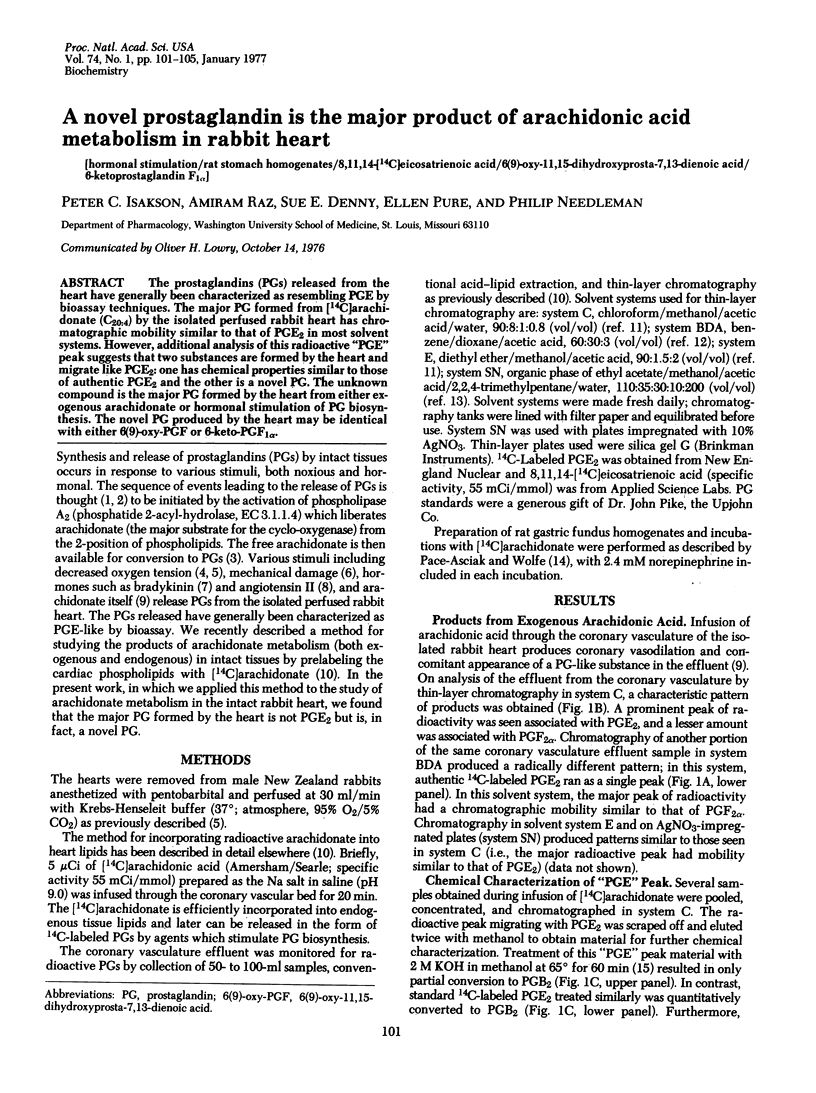
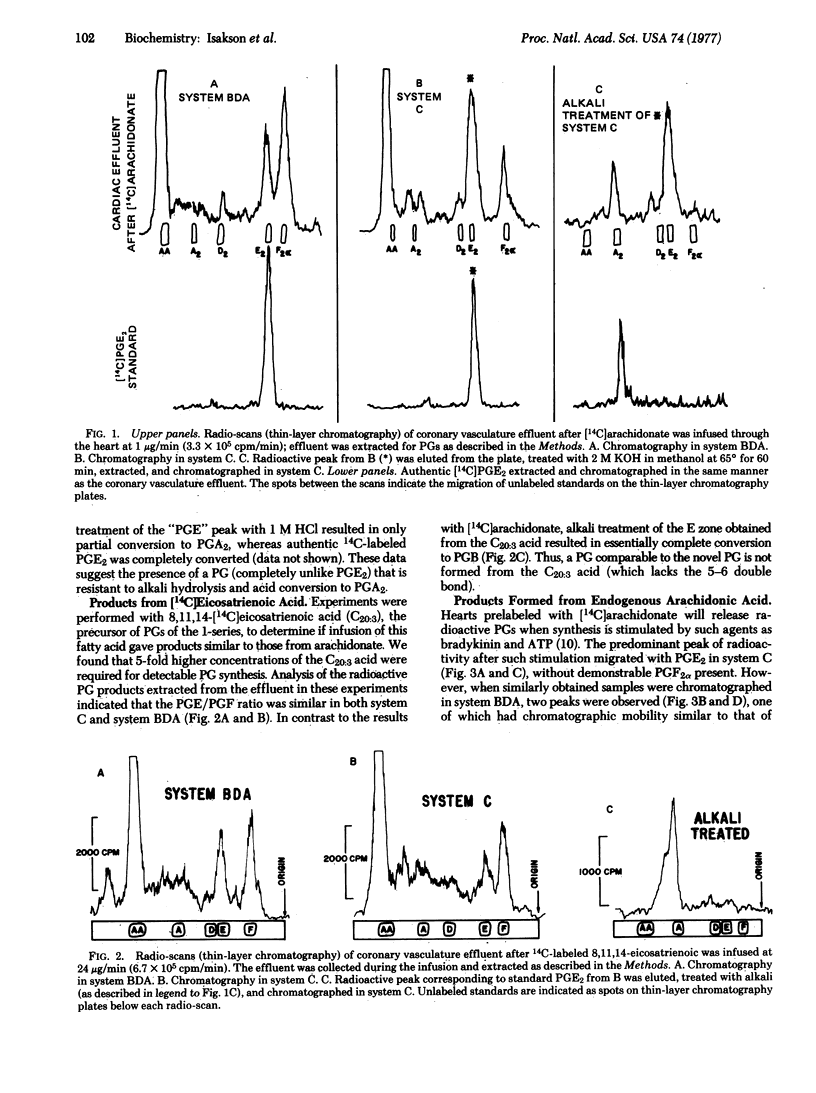
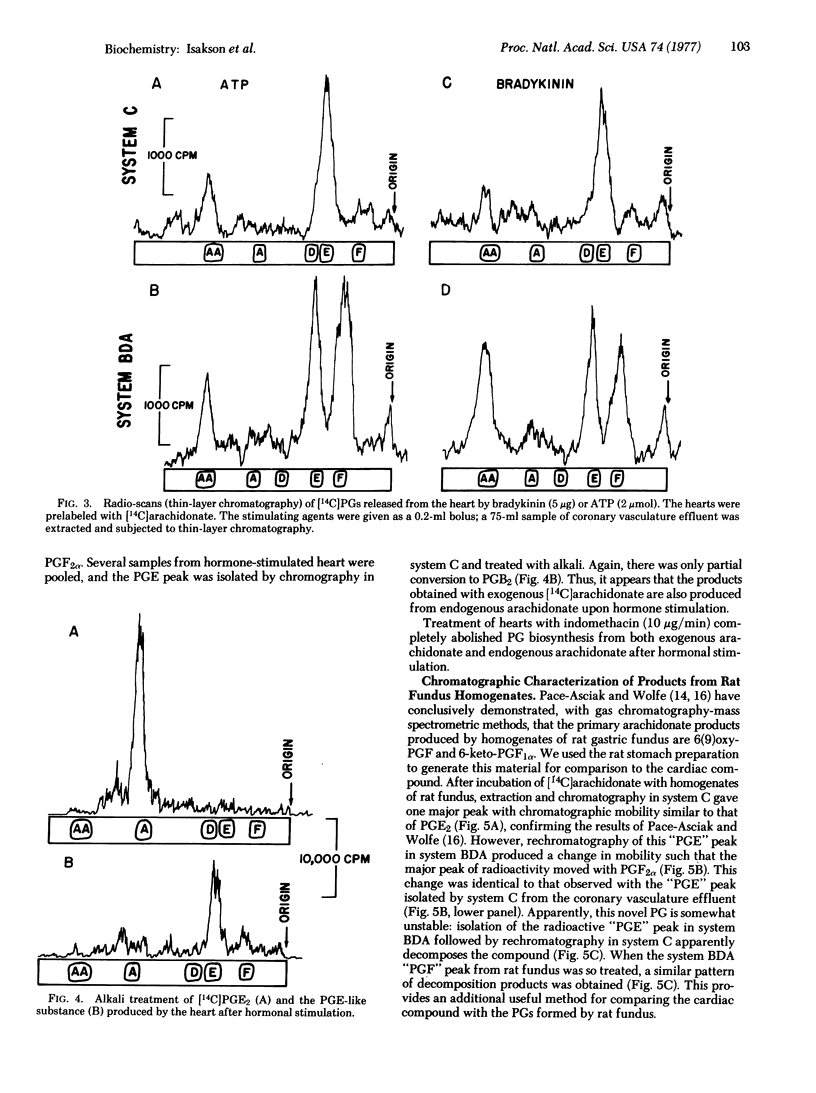
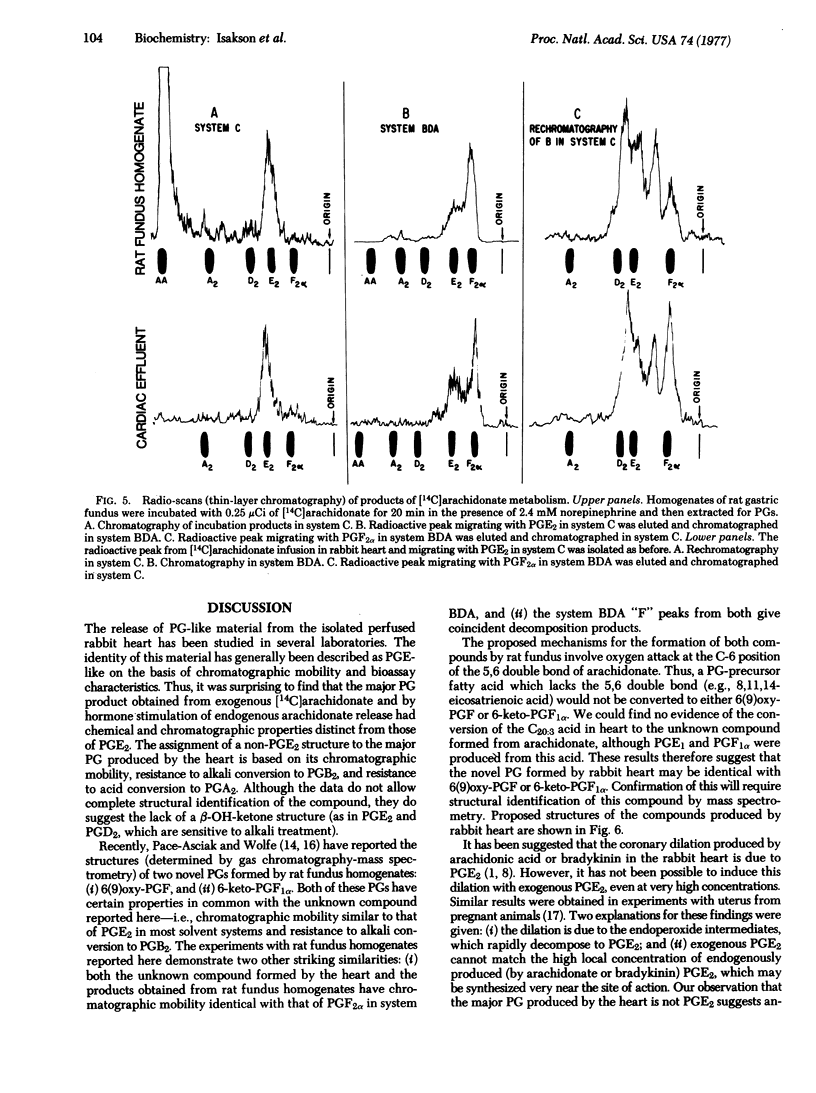
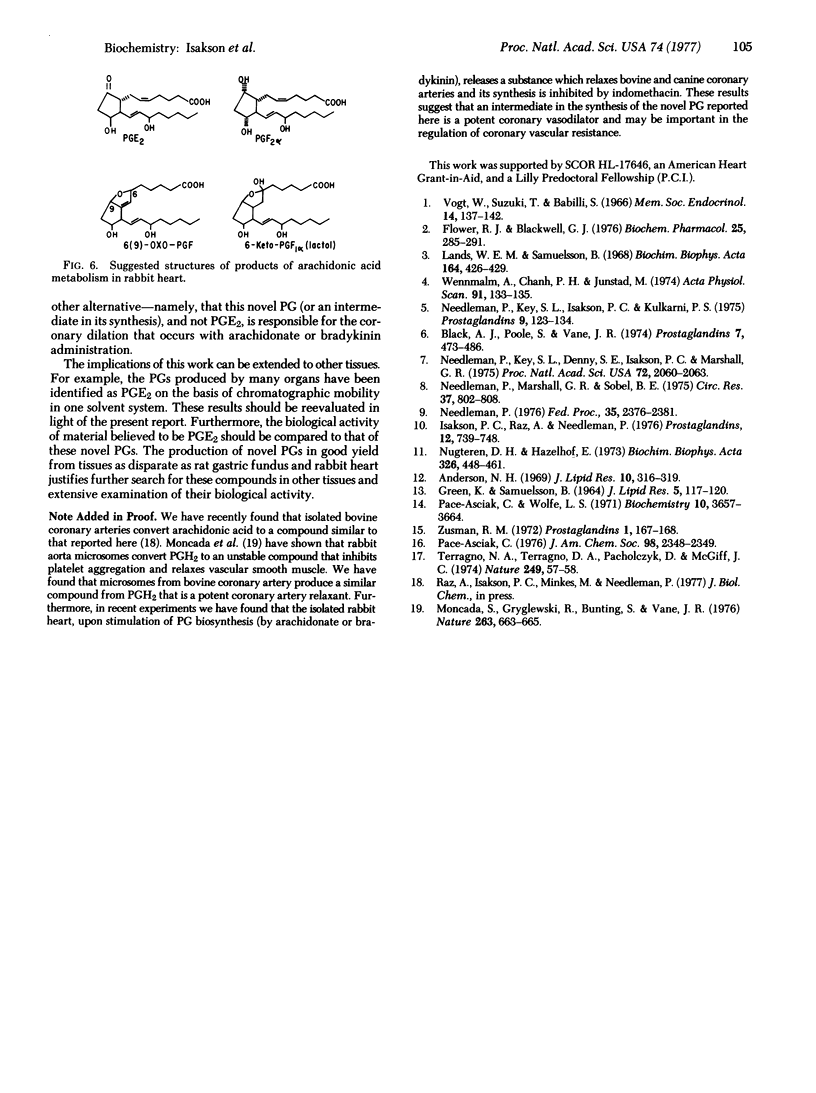
Selected References
These references are in PubMed. This may not be the complete list of references from this article.
- Anders N. H. Preparative thin-layer and column chromatography of prostaglandins. J Lipid Res. 1969 May;10(3):316–319. [PubMed] [Google Scholar]
- Block A. J., Poole S., Vane J. R. Modification of basal release of prostaglandins from rabbit isolated hearts. Prostaglandins. 1974 Sep 25;7(6):473–486. doi: 10.1016/0090-6980(74)90092-6. [DOI] [PubMed] [Google Scholar]
- Flower R. J., Blackwell G. J. The importance of phospholipase-A2 in prostaglandin biosynthesis. Biochem Pharmacol. 1976 Feb 1;25(3):285–291. doi: 10.1016/0006-2952(76)90216-1. [DOI] [PubMed] [Google Scholar]
- GREEN K., SAMUELSSON B. PROSTAGLANDINS AND RELATED FACTORS: XIX. THIN-LAYER CHROMATOGRAPHY OF PROSTAGLANDINS. J Lipid Res. 1964 Jan;5:117–120. [PubMed] [Google Scholar]
- Isakson P. C., Raz A., Needleman P. Selective incorporation of 14C-arachidonic acid into the phospholipids of intact tissues and subsequent metabolism to 14C-prostaglandins. Prostaglandins. 1976 Nov;12(5):739–748. doi: 10.1016/0090-6980(76)90049-6. [DOI] [PubMed] [Google Scholar]
- Lands W. E., Samuelsson B. Phospholipid precursors of prostaglandins. Biochim Biophys Acta. 1968 Oct 22;164(2):426–429. doi: 10.1016/0005-2760(68)90168-9. [DOI] [PubMed] [Google Scholar]
- Moncada S., Gryglewski R., Bunting S., Vane J. R. An enzyme isolated from arteries transforms prostaglandin endoperoxides to an unstable substance that inhibits platelet aggregation. Nature. 1976 Oct 21;263(5579):663–665. doi: 10.1038/263663a0. [DOI] [PubMed] [Google Scholar]
- Needleman P., Key S. L., Denny S. E., Isakson P. C., Marshall G. R. Mechanism and modification of bradykinin-induced coronary vasodilation. Proc Natl Acad Sci U S A. 1975 Jun;72(6):2060–2063. doi: 10.1073/pnas.72.6.2060. [DOI] [PMC free article] [PubMed] [Google Scholar]
- Needleman P., Key S. L., Isakson P. C., Kulkarni P. S. Relationship between oxygen tension, coronary vasodilation and prostaglandin biosynthesis in the isolated rabbit heart. Prostaglandins. 1975 Jan;9(1):123–134. doi: 10.1016/s0090-6980(75)80123-7. [DOI] [PubMed] [Google Scholar]
- Needleman P., Marshall G. R., Sobel B. E. Hormone interactions in the isolated rabbit heart. Synthesis and coronary vasomotor effects of prostaglandins, angiotensin, and bradykinin. Circ Res. 1975 Dec;37(6):802–808. doi: 10.1161/01.res.37.6.802. [DOI] [PubMed] [Google Scholar]
- Needleman P. The synthesis and function of prostaglandins in the heart. Fed Proc. 1976 Oct;35(12):2376–2381. [PubMed] [Google Scholar]
- Nugteren D. H., Hazelhof E. Isolation and properties of intermediates in prostaglandin biosynthesis. Biochim Biophys Acta. 1973 Dec 20;326(3):448–461. doi: 10.1016/0005-2760(73)90145-8. [DOI] [PubMed] [Google Scholar]
- Pace-Asciak C. Letter: Isolation, structure, and biosynthesis of 6-ketoprostaglandin F1 alpha in the rat stomach. J Am Chem Soc. 1976 Apr 14;98(8):2348–2349. doi: 10.1021/ja00424a065. [DOI] [PubMed] [Google Scholar]
- Pace-Asciak C., Wolfe L. S. A novel prostaglandin derivative formed from arachidonic acid by rat stomach homogenates. Biochemistry. 1971 Sep 28;10(20):3657–3664. doi: 10.1021/bi00796a004. [DOI] [PubMed] [Google Scholar]
- Terragno N. A., Terragno D. A., Pacholczyk D., McGiff J. C. Prostaglandins and the regulation of uterine blood flow in pregnancy. Nature. 1974 May 3;249(452):57–58. doi: 10.1038/249057a0. [DOI] [PubMed] [Google Scholar]
- Wennmalm A., Pham-Huu-Chanh, Junstad S. Hypoxia causes prostaglandin release from perfused rabbit hearts. Acta Physiol Scand. 1974 May;91(1):133–135. doi: 10.1111/j.1748-1716.1974.tb05666.x. [DOI] [PubMed] [Google Scholar]
- Zusman R. M. Quantitative conversion of PGA or PGE to PGB. Prostaglandins. 1972 Feb;1(2):167–168. doi: 10.1016/0090-6980(72)90079-2. [DOI] [PubMed] [Google Scholar]


